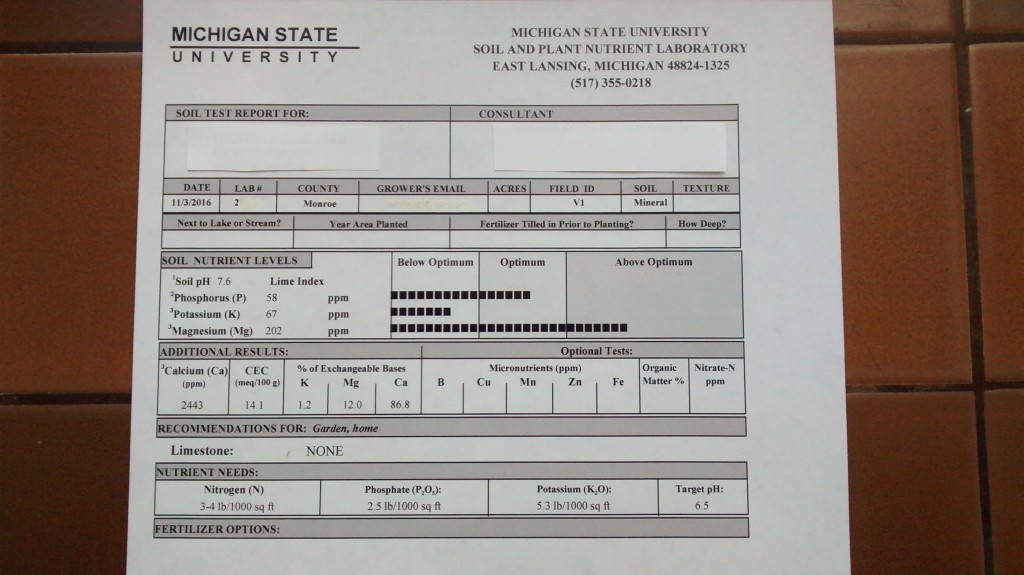You’ve read it here in this blog, you’ve heard it from your neighbor, even your Aunt Bootsie told you to get a soil test for your garden. I’ve always recommended using the soil testing lab at Michigan State University, it’s the “gold standard” of soil labs in Michigan. For most gardens a basic test will provide you with all the information you’ll need.
In past blogs I’ve described how to properly take a soil sample for testing and what to do with it once you’ve collected it, so we won’t discuss that today. Instead we’ll look at actual soil test results.
Once you’ve rounded up a bag of dirt, sent it to the lab along with your payment, the MSU soil lab will test your sample, processes the results and send you the test results either by email or by mail. That usually happens within ten days.
Let’s take a peek at an actual soil test readout I received last fall.
The first test result is the soil pH. pH describes how acid or how alkaline your soil is with “7″ being neural. In this case the sample result is 7.6 which is somewhat alkaline. So right away we know we won’t have to add any lime to raise the soil pH since most garden plants grow best in a slightly acidic soil.
Next is the result for phosphorus, the “P” in NPK. The result came back at 58 ppm (parts per million) which, according to the graph is well in the optimum range.
Following P we see that is the potassium (K) is 67 ppm which we see is below optimum. Magnesium (Mg) at 202 ppm is above the optimum range.
Calcium(Ca), shown in the additional results section is 2443 ppm which helps to explain the relatively high soil pH reading since calcium will raise soil pH.
The next result is CEC (cation exchange capacity) this tells us how well the soil is able to retain soil nutrients. A reading of 14.1 tells us we can add fertilizer to this garden without having it leach out of the soil. Usually, soil types with a higher percentage of clay in their make-up have a higher CEC and therefore are inherently more fertile because of all the retained nutrients. Very sandy soils have low CEC values. It is very difficult to change the CEC of a soil. On the other hand, we can easily raise the NPK values by simply adding fertilizer.
Those cations (positive-charged ions) that are being described in the CEC reading are mostly K, Mg and Ca. There is a section in the readout providing the percentage of each of those. Phosphorus is not listed there because it exists in the soil as negatively charged anion (PO4 3-).
Nitrogen (N) is not tested for at MSU because soil nitrogen levels change with the temperature and other variables so you would never get an accurate reading.
We don’t have room here to discuss the soil science behind the results. Fortunately, the soil lab boils it all down to some simple recommendations at the bottom of the readout.
The nutrient needs are listed as actual pounds of each element per 1000 square feet. Since fertilizer is not sold as pure nitrogen, phosphorus or potassium, the precise amount of any type of fertilizer must be mathematically calculated. Back in the olden days when I was an MSU Extension Agent and the results were printed with a dot-matrix printer, I made those calculations by hand on hundreds of test results. Nowadays MSU has an online calculator that you can use to figure out how many pounds of fertilizer you would need to apply.
With the planting season rapidly approaching,I suggest you get your soil sample to the lab ASAP. Much like your income tax return; the sooner you send it in the sooner you’ll see your results.
Bob






